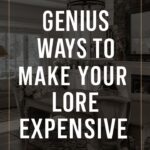Introduction
Designing small spaces presents a unique set of challenges. With limited square footage, every inch becomes precious, demanding innovative approaches to utilize the available area efficiently. The endeavor of decorating a petite home, apartment, or even a single room requires creativity and strategy. Crafted thoughtfully, these living spaces can be transformed into functional havens without sacrificing style or comfort. The task lies in striking a careful balance between functionality and aesthetics in compact living, ensuring that every element serves a dual purpose – practical utility and visual appeal.
Challenges of Designing Small Spaces
The primary challenge in designing a small space is the limited area available for multiple functionalities and desired activities. Unlike larger homes where space permits more freedom, small spaces demand strategic thinking to avoid overcrowding and clutter. The key is to focus on utility while maintaining a welcoming and comfortable environment. Cohesion and practicality should remain at the forefront, ensuring that decor and furniture selections do not impair the usability of the space.
Importance of Functionality and Aesthetics in Compact Living
In compact spaces, functionality should flow harmoniously with aesthetics. Each piece of furniture and every decorative element should serve not only a visual purpose but also a practical one. A well-designed small space feels seamless and thoughtful, whereas an ill-conceived one can feel claustrophobic and cluttered. Ensuring that style and practicality coexist can be the defining factor that sets a successful design apart.
Maximizing Natural Light in Small Spaces
Natural light plays a critical role in enhancing the perception of space. It can transform a small, constrained area into a bright and airy haven, imbuing it with a sense of openness. Exploiting natural light as much as possible should be a cornerstone strategy in any small space design plan.
Tips for Using Mirrors to Reflect Light
Mirrors are an interior designer’s best friend when it comes to maximizing perceived space. Placing mirrors opposite windows can significantly amplify the influx of natural light, reflecting it deeper into the room and making it seem larger. The clever use of mirrors can create an illusion of continuity and openness, tricking the eye into perceiving nightmarishly tight quarters as more generous.
Choosing Light-Colored Curtains or Blinds to Enhance Brightness
Opting for light-colored curtains or blinds is a strategic choice to enhance a room’s brightness. Pale shades allow more light to filter through, bathing the area in a soft, inviting glow. This simple yet effective technique can enliven a space, making it feel spacious and cheerful without significant alterations.
Opting for Multi-Functional Furniture
In a small space, dual-purpose furniture is a true game-changer. Selecting pieces that serve more than one function can save precious square footage while allowing flexibility in how the space is used.
Sofa Beds, Storage Ottomans, and Foldable Tables
Multi-functional furniture items such as sofa beds, storage ottomans, and foldable tables are quintessentially practical. A sofa bed can easily transition a living area into a guest room, while storage ottomans offer a space for keeping infrequently used items out of sight. Foldable tables, which can be expanded when needed and tucked away when not, provide flexibility without unnecessary bulk.
How Multi-Purpose Furniture Saves Space Without Compromising Style
Multi-purpose furniture marries practicality with style, drawing on innovative design to deliver pieces that are both functional and aesthetically pleasing. These versatile items enable homeowners to tackle spatial constraints by offering dual or even multiple uses. By doing so, they contribute to a seamless, clutter-free environment that maintains chicness and style.
Like Us on Facebook!
Choosing Light and Neutral Color Palettes
A well-chosen color palette can dramatically alter the perception of a space, making it seem more expansive and open. Light and neutral colors, in particular, possess transformative powers in small rooms.
Subscribe Us on YouTube!
The Effect of Light Colors on Making Spaces Feel Larger
Light colors such as whites, creams, and pastels reflect more light than darker tones, imbuing a room with an airy and open feel. These shades can deceive the eye into perceiving a space as larger than it is, while also providing a neutral canvas that allows flexibility in interior decoration.
Using Pops of Color in Accessories and Decor for Interest
While light and neutral colors form the foundation of small space design, incorporating pops of color can inject personality and interest. Vibrant accessories and decor items can add depth and character, engaging the eye and offering visual relief from the homogeneity of neutrals.
Utilizing Vertical Space
In compact spaces, thinking vertically can provide the extra room needed for storage and decoration. By building upwards, one can maximize the use of limited real estate while keeping the floor uncluttered.
Installing Wall-Mounted Shelves and Cabinets
Wall-mounted shelves and cabinets are excellent solutions for expanding storage capacity without consuming floor space. They allow for the strategic display and storage of items, keeping them accessible and organized while ensuring the area below remains open and free.
How to Use Tall Furniture to Draw the Eye Upwards
Tall furniture can lead the gaze upwards, creating an impression of height and spaciousness. By integrating high bookshelves, towering wardrobes, or elongated plants, one can effectively utilize vertical space and give the room a more open feel.
Creating Open Layouts with Minimal Clutter
An open layout is essential to making a small space feel expansive. By reducing clutter and creating a cohesive flow, the space becomes not only functional but also inviting.
Decluttering Tips for Small Spaces
Decluttering is crucial in small space interior design. Emphasize quality over quantity by curating a selection of essential and cherished items. Incorporate smart storage solutions to keep areas tidy and open, ensuring that each item has a dedicated place.
How to Create a Minimalist, Open Feel with Furniture Placement
Furniture placement can make a significant difference in how a small space functions. Arrange furniture to maintain clear pathways and ensure spatial flow. Avoid cramming pieces into tight corners, instead opting for arrangements that promote an airy and uncluttered ambiance.
Using Mirrors to Create the Illusion of Space
Mirrors extend perspectives and double perceptions, making them an invaluable tool in small-space design.
Where to Place Mirrors for Maximum Impact
Position mirrors to reflect both natural light and captivating vistas. Hang them opposite windows to capture and enhance incoming daylight. Use reflective furniture, like mirrored side tables, to amplify luminosity and openness further.
Choosing Mirror Shapes and Sizes That Suit the Room
Select mirror shapes and sizes thoughtfully, encouraging harmony with the room’s proportions. Oversized mirrors can create a bold statement, expanding the space visually. However, in tight spots, a series of smaller mirrors, strategically placed, can achieve similar effects without overwhelming the area.
Incorporating Smart Storage Solutions
Smart storage solutions are indispensable in small spaces, allowing for organization and accessibility without overconsuming precious square footage.
Hidden Storage Options Like Under-Bed Drawers or Wall-Mounted Units
Hidden storage solutions such as under-bed drawers or wall-mounted units can help clear surfaces while maintaining functionality. These elements create room to stow away essentials discreetly, maximizing every inch available effectively.
Maximizing Storage in Small Kitchens and Bathrooms
Compact kitchens and bathrooms benefit from clever storage ideas such as magnetic strips for knives or pull-out baskets for toiletries. Vertical space, like cabinet tops and doors, can also be utilized for storage, ensuring essentials are close at hand yet out of sight.
Choosing the Right-Size Furniture
Selecting proportionate furniture is vital in maintaining equilibrium in small spaces. Oversized furniture can disrupt balance, limiting functionality and diminishing the room’s aesthetic.
Tips for Picking Proportionate Furniture for Small Spaces
Choose furniture that feels right for the space, opting for slim profiles and compact designs. Avoid bulkiness that can strain the room’s flow. Consider furniture with raised legs to enhance visibility of the floor, fostering an illusion of expanded area.
How to Avoid Overwhelming the Room with Large Pieces
While statement pieces can elevate a room’s style, they must be balanced with the room’s scale. Selectively incorporate large accents only where functionality truly demands it. Wisely distribute furniture to best utilize available room without hindering movement or encroaching upon visual space.
Creating Visual Divisions in Multi-Use Spaces
In open-floor layouts or studio apartments, effective division of space without building barriers is essential for functionality and comfort.
Using Rugs, Curtains, or Shelving to Define Different Areas
Layer textures such as rugs, curtains, or open shelving to delineate distinct zones in a shared space. Rugs can designate dining or seating areas while curtains may separate sleeping quarters without incurring construction efforts.
How to Separate Living, Dining, and Workspaces in Small Rooms
Designing multi-use spaces requires creativity. Consider foldable or movable partitions or furniture designed to shift form and function. Strategic placement of furniture and decor can naturally suggest boundaries, guiding movements organically from one area to another.
Conclusion
The key to adeptly designing small spaces lies in strategic planning and thoughtfulness. Focus on well-balanced choices that enhance functionality without compromising aesthetics. Personalized small spaces, with these tips, can become havens of style and comfort, regardless of size constraints. Transform your compact abode into a sanctuary that reflects innovation, personality, and resourcefulness.


















